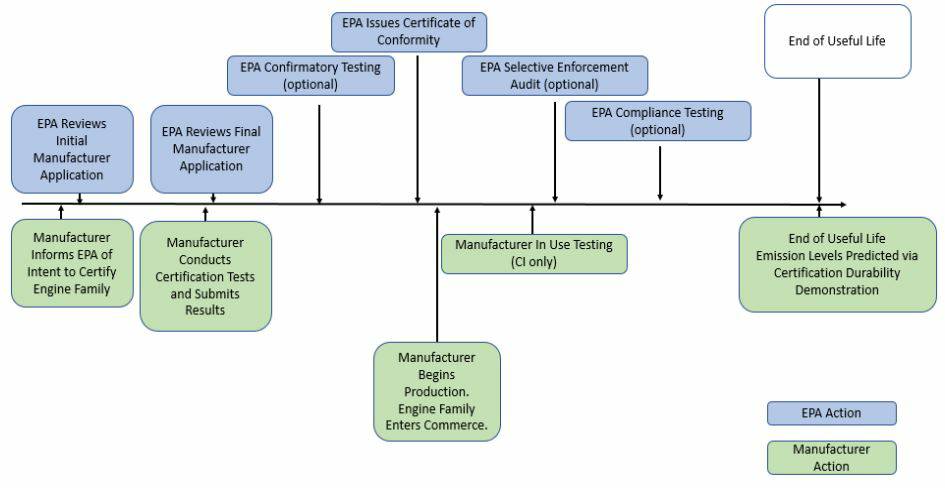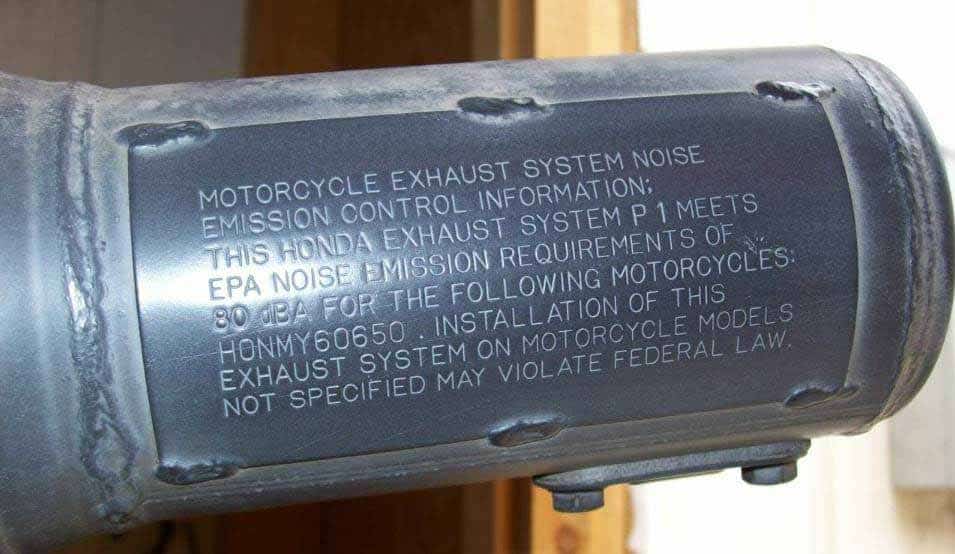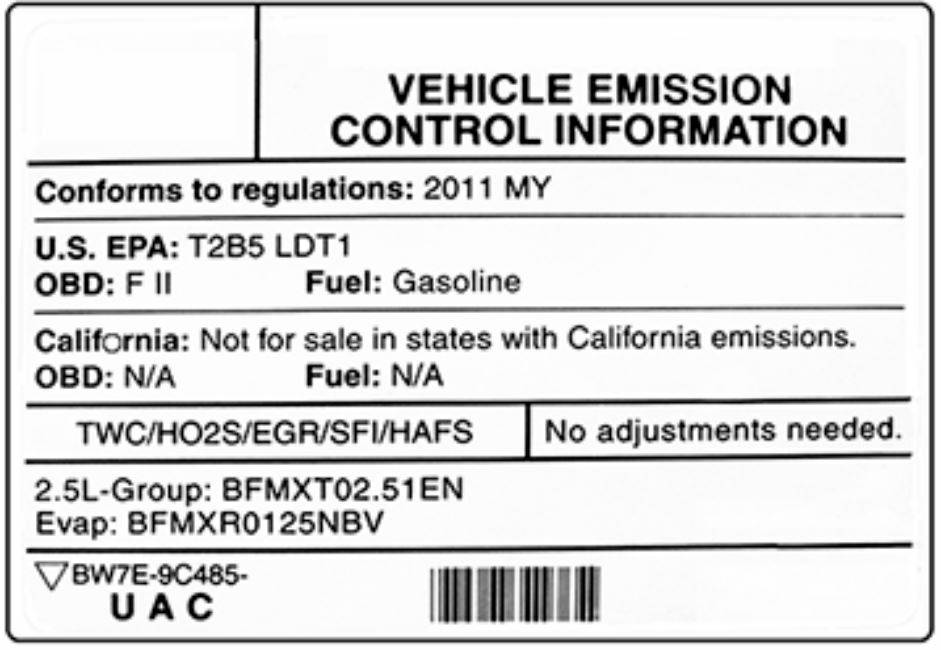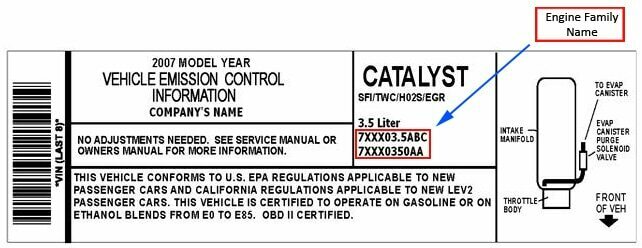Motorcycles in the United States are regulated under section 202 of the Clean Air Act (Since it was amended in 1990), which calls for the Environmental Protection Agency (EPA) to consider the need to achieve equivalent emissions reductions from motorcycles as much as possible. The act prohibits the importation into the United States of any motorcycle and motorcycle engine that does not conform to the EPA emission standards and requirements. These standards apply to all motorcycles and motorcycle engines, whether they are new or used, manufactured domestically or abroad.
Starting in 2009, CO2 standards are only set by the EPA, while the National Highway Traffic Safety Administration (NHTSA) sets fuel economy standards. Today, the CO2 and fuel consumption standards apply to model years 2017–2025 motorcycles.

For all model years from 1978-2005, motorcycles were regulated by a single unchanging set of standards. On 15 January 2004, EPA’s Control of Emissions from Highway Motorcycles Rule (69 FR 2398) established 2 tiers of conventional pollutant exhaust emissions standards for highway motorcycles in the United States. Tier 1 came into effect in 2006 and remains in effect for Class I and II motorcycles. In 2010, standards for Class III motorcycles were updated to Tier 2 standards.
Highway motorcycle standards adopted by EPA are in line with California’s motorcycle standards, but typically, with a two-year delay in implementation. When the EPA released the Tier 1 and Tier 2 standards in 2004, it stated that “the 2006 EPA HC and NOx standards are roughly comparable to and perhaps somewhat less stringent than the California Tier 2 motorcycle standards effective in 2008.”
EPA Motorcycle Certification in The United States
Technical Standards
The following table outlines motorcycle classes.
| Class | Engine Size (cc) |
| Class I-A (Mopeds and scooters) | <50 cc |
| Class I-B | 50-169 cc |
| Class II | 170-279 cc |
| Class III | 280+ cc |
-
Tier 1 Exhaust Program (2006)
Starting with the 2006 model year, EPA re-defined Class I to include motorcycles with engines smaller than 50cc. These new previously unregulated vehicles are Class I-A, and the pre-existing Class I became Class I-B. The standards began in 2008 for small manufacturers.
The following table shows the exhaust standards for highway motorcycles, including scooters and mopeds.
-
Tier 1 Highway Motorcycle Exhaust Emission Standards
| Class | Engine Size (cc) | Useful Life/Warranty | HC (g/km) | HC + NOx** (g/km) | CO (g/km) |
| Class I-A | < 50 (Mopeds & scooters) | 5 yr/6,000 km | – | – | – |
| Class I-B | 50-169 | 5 yr/12,000 km | 1.0 | 1.4 | 12.0 |
| Class II | 170-279 | 5 yr/18,000 km | 1.0 | 1.4 | 12.0 |
| Class III | > 279 | 5 yr/30,000 km | – | 1.4 | 12.0 |
| Notes: Useful life and warranty period, whichever comes first, is the period over which the manufacturer must demonstrate compliance with emission standards. It is unrelated to how long a consumer can keep or ride a motorcycle.
This is an optional standard that allows manufacturers to average their emissions or transfer emission credits across classes. |
|||||
-
Tier 2 Exhaust Program (2010)
Tier 2 emission standards affect Class III motorcycles and took effect in 2010. Small manufacturers (less than 3000 US sales and fewer than 500 employees) are currently exempt from Tier 2.
-
Tier 2 Highway Motorcycle Exhaust Emission Standards
| Class | Engine Size (cc) | Useful Life/Warranty* | HC + NOx (g/km) | CO (g/km) | NOx (g/km) |
| Class III | > 279 | 5 yr/30,000 km | 0.8 | 12.0 | n/a |
Additional provisions of the Tier 2 standards are as follows:
Averaging
- Manufacturers may meet the HC+NOx standard on average, which enables them to sell motorcycles using a range of technologies.
Additional Requirements
Effective from 2008 (2010 for small manufacturers)
Low permeation fuel tanks and hoses required:
- Metal tanks meet the standards by definition (90%+ of motorcycles have metal fuel tanks)
- Plastic tanks can use several existing barrier technologies to meet the standards (~10% of motorcycles have plastic tanks)
- Existing fuel hose technology using barrier treatments or materials qualify as low permeation hoses
Hardship Provisions:
- Unusual circumstances, accompanied by good faith efforts to comply with standards (and if solvency is in jeopardy), may result in the waiving of requirements for any sized manufacturer.
- Upon demonstration of good faith efforts to comply with standards (and if solvency is in jeopardy), the deadline for compliance for small bike makers may be extended if the burden of compliance is a problem.
EPA: Testing at the National Vehicle and Fuel Emissions Laboratory (NVFEL)
EPA’s National Vehicle and Fuel Emissions Laboratory (NVFEL) tests a portion of all motorcycle engines — including on-road and non-road gasoline engines 30HP and smaller — intended for sale and use in the United States to confirm compliance with EPA’s exhaust emissions standards. If the motorcycle kits or modified motorcycles have engines that are 50cc or greater, the company must subject them to EPA’s conformity testing. This is true regardless of whether the company modifies the motorcycles, or only sells motorcycles with the upgrade kits.
EPA’s standards don’t distinguish between two-strokes and four-strokes; motorcycles are separated by displacement only and must meet the same limits. A motorcycle is excluded from the testing if it has a displacement of less than 50cc or if with a 176 lbs. (80kgs) rider, it cannot start from a dead stop using only the engine or exceed a speed of 25 mph (40 km/h) on a level, paved surface.
To evaluate the engines’ in-use compliance with EPA’s regulations, engines are tested under standard test cycles specially designed to account for the unique conditions of each engine’s application to meet federal emission standards such as limits on the amount of smog-forming and greenhouse gas emissions that they can produce. Test procedures for motorcycles are detailed in 40 CFR Part 86 Subpart F. This outlines sections on test procedure specifics including dynamometers, exhaust gas sampling, analytical systems, fuel, and engine lubrication and lubricant specifications, analytical gasses, calibrations, frequency and overview, transmissions, vehicle preparations, analysis, and calculations.
For instance, EPA’s Tier 1 levels that went into effect in 2006 for motorcycles 170-279 cc (this class of motorcycles represents about 5-10 percent of annual U.S. motorcycle sales) call for maximum limits of 1.4g/km (grams per kilometer) combined HC and NOx, and 12g/km CO. The standards call for an 80 dBA maximum sound level.
Most testing is performed by the motorcycle manufacturers at their own facilities. EPA’s NVFEL then audits the data and performs its own testing on some of the units to confirm the manufacturers’ results. The ISO-17025:2017 accredited and ISO-14001:2015 certified state-of-the-art test facility provides a wide array of analytical testing and engineering services for the agency’s programs to support its regulatory goals
To submit your engine for conformity testing, follow this process:
- Identify the Test Engine: After receiving your test order from EPA, identify the test engine you will send to EPA. If desired, test the engine at your facility prior to shipment. Refer to the contact person on your test order for additional information.
- Ship the Test Engine to EPA: When requested by EPA, ship the engine to the location specified in your test order.
- Confirm That You Have Access to Engines and Vehicles Compliance Information System (EV-CIS): You must register with EPA to gain access to CDX’s EV-CIS in order to submit initial test setup documents. You must also set up an account with EPA to establish the “Upload Compliance Documents” role in EV-CIS.
- Prepare the Engine Test Setup Documents: Use the following materials to create your test setup documents: CDX document upload instructions for nonroad engine manufacturers, Setup documents for small SI engines, & Setup documents for heavy-duty CI engines
- Submit the Engine Test Setup Documents in EV-CIS: Login to EV-CIS through the CDX portal: Central Data Exchange (CDX). Submit the completed documents and upload any required supporting materials.
- Confirm That Your Submission(s) From Step 5 Were Accepted By EV-CIS: Within a few minutes of all submissions, the submitter will receive a notification in their CDX inbox indicating whether the submission was accepted or rejected. To access your CDX inbox, click the “Inbox” link on the left navigation bar of the MyCDX homepage.
- Determine Whether to Attend Test Setup; Review the Test Procedure: EPA will notify the engine manufacturer approximately two weeks prior to the start of testing. Manufacturers can attend the test setup but are not permitted to observe the testing. Manufacturers who plan to attend test setup must inform the EPA certification representative or the contact listed in the test order. For more information on the test procedure, see: Process flow chart for the EPA test procedure.
- Review Draft Emissions Test Report and, If Needed, Make Mechanical Repairs: Manufacturers will be notified upon completion of a valid confirmatory test and allowed to review the draft emissions test report on the first day of testing. If the engine should fail the first emission test, the manufacturer will be permitted to make mechanical repairs to the engine on the second day. Any changes made to the engine must be documented and provided in writing or electronically to EPA certification personnel at the time of testing.
- Receive Official Test Results: The official test results will be mailed to the manufacturer and will also be sent to the user’s CDX inbox. To access your CDX inbox, click the “Inbox” link on the left navigation bar.
How to Get the EPA Certificate of Conformity for a Motorcycle

A Certificate of Conformity is the document that EPA issues to a motorcycle manufacturer to certify that the motorcycle class conforms to EPA requirements. Every class of motorcycle introduced into commerce in the United States must have a Certificate of Conformity. Certificates are valid for only one model year of production
-
How Much Is the EPA’s Motorcycle Conformity Certificate?
EPA must receive the proper certification fee and fee filing form before starting to review a manufacturer’s certification application for a given test group or engine family.
Currently, the fee for highway Motorcycles, including ICIs, is $1,852**. However, fee rates are adjusted each year and apply to the calendar year in which EPA receives the application.
Official documentation of these fees and related information is provided in the guidance letters: https://dis.epa.gov/otaqpub/
Notice: To determine if other payment methods may be available as an alternative to Pay.gov, please contact the EPA at 202-564-7593.
Accepted Payment Methods:
- Bank account (ACH)
- Amazon account
- PayPal account
- Debit or credit card
Here is the U.S. EPA Fee Form: the https://www.pay.gov/public/form/preview/pdf/102
-
How Long Does It Take to Get EPA Motorcycle Conformity Certificate?
The time it takes to get an EPA Conformity Certificate varies and is dependent on the complexity of the applicant’s activities and operations. The time frame varies between around one month (30 days) and up to four months (120 days) for more complex assessments.
To get your EPA Certificate of Conformity, follow this process:
- Confirm That You Have Access to EV-CIS: Engines and Vehicles Compliance Information System (EV-CIS), formerly the Verify System, is EPA’s compliance information system. Register for EV-CIS in these two steps: Company Registration for EV-CIS and Account Setup for EV-CIS.
- Update Manufacturer Information in EV-CIS: To update information, users must have the “Maintain Manufacturer Information” role in the EV-CIS system. Otherwise, users will only be able to view the information. Updates include (but are not limited to): Industry sector(s), Addresses, Contacts and Industry/Compliance Programs, Test labs, and Notification email addresses (used for EV-CIS’s broadcast notifications).
- Review All Applicable Regulations: Regulations provide requirements for certification and compliance.
- For on-road motorcycles, review the following: 40 CFR Part 86, Subpart E, 40 CFR Part 86, Subpart F & 40 CFR Part 1051. Also, review selected guidance letters: Information about Family Naming Conventions. To search all guidance letters, go to EPA’s Transportation and Air Quality Document Index System (DIS).
- For non-road motorcycles, review the following: 40 CFR Part 1051, 40 CFR Part 1065, and 40 CFR Part 1068. Also, review selected guidance letters: Information about Family Naming Conventions and Road Force Target Coefficients for Vehicles Over 870kg, Certified Under 40 CFR Part 1051 (PDF) (2 pp, 118 K, August 2014, About PDF). To search all guidance letters, go to EPA’s Transportation and Air Quality Document Index System (DIS).
- Pay Appropriate Certification Fees, As Applicable: A fee payment may be required for each certificate issued by EPA. For more details, go to: Fees Information.
- Prepare Certification Application Materials: For each model year for an Engine Family, you must provide the applicable certification dataset and supporting materials.
- Submit the Completed Certification Application Materials in EV-CIS: Login to the EV-CIS System through the CDX portal: Central Data Exchange (CDX). Click the applicable industry role on the MyCDX homepage. Submit the completed certification dataset and upload any required supporting materials.
- Confirm That Your Submission(s) from Step 6 Were Accepted by EV-CIS: Within a few minutes of all submissions, the submitter will receive a notification in their CDX inbox indicating whether the submission was accepted or rejected. To access your CDX inbox, click the “Inbox” link on the left navigation bar of the MyCDX homepage.
- Submit a Request for Certificate (RFC): A CROMERR signer must submit an RFC for each Engine Family. To do so, click the “CROMERR Signer” role on your MyCDX homepage.
- Receive Certificate of Conformity: The CROMERR signer will receive the certificate in his or her CDX inbox. To access your CDX inbox, click the “Inbox” link on the left navigation bar.
What’s Next?
Once you have received your Certificate of Conformity, you need to submit the required compliance reports. Follow these steps:
1. Confirm That You Have Access to EV-CIS: You must register with EPA to gain access to the EV-CIS system for the specific manufacturer code for which you are seeking certification. You must also set up an account with EPA to establish the necessary EV-CIS roles.
2. Update Manufacturer Information in EV-CIS: To update information, users must have the “Maintain Manufacturer Information” role in the EV-CIS system. Otherwise, users will only be able to view the information.
3. Review All Applicable Regulations: Regulations provide requirements for certification and compliance.
- For on-road motorcycles, review the following: 40 CFR Part 85, & 40 CFR Part 86. Also, review selected guidance letters: Changes in Submission Process of Emissions-Related Defect and Recall Reports under 40 CFR Part 85, Subparts S and T (PDF) (1 pg., 67 K, August 15, 2016, About PDF). To search all guidance letters, go to EPA’s Transportation and Air Quality Document Index System (DIS).
- For non-road motorcycles, review the following: 40 CFR Part 1051, 40 CFR Part 1065, and 40 CFR Part 1068. Also, review selected guidance letters: Changes in Submission Process of Emissions-Related Defect and Recall Reports under 40 CFR Part 1068, Subpart F (PDF) (1 pg., 67 K, August 1, 2016, About PDF). To search all guidance letters, go to EPA’s Transportation and Air Quality Document Index System (DIS).
4. Prepare Compliance Reporting Materials:
- For on-road motorcycles, download and complete these materials: Template for Annual Production Report and Report Forms and Guidance for Defects and Recalls under 40 CFR Part 85, Subparts S and T.
- For non-road motorcycles, download and complete these materials: Template for Annual Production Report, Report forms and guidance for defects and recalls under 40 CFR Part 1068, Subpart F, and Template for Replacement Engine Exemption Report.
5. Submit the Completed Applicable Compliance Reporting Materials in EV-CIS: Login to the EV-CIS System through the CDX portal: Central Data Exchange (CDX). Submit the completed applicable compliance reporting materials by the required deadlines.
6. Confirm That Your Submission(s) From Step 5 Were Accepted By EV-CIS: Within a few minutes of all submissions, the submitter will receive a notification in their CDX inbox indicating whether the submission was accepted or rejected. To access your CDX inbox, click the “Inbox” link on the left navigation bar of the MyCDX homepage.
What About Non-Conforming Motorcycles and Engines?
Can be imported in two circumstances:
-
By Certification:
Nonconforming motorcycles can be imported, if they are modified, tested, and certified by an Independent Commercial Importer (ICI).
EPA regulations also allow nonconforming motorcycles and engines to be temporarily imported under U. S. Customs and Border Protection bond, if they qualify for an EPA exemption. EPA and Customs regulations allow for the temporary importation of nonconforming motorcycles with EPA pre-approval for the following purposes:
-
By Exemption:
- Testing
- Display
- Repair or Alteration
- Nonresident
- Competition/Racing
Before shipping a nonconforming motorcycle or engine to the United States, importers must either:
- Make arrangements with an ICI for modifications, testing, and certification,
or
- Obtain EPA pre-approval for the exemptions listed above.
Importation of Used Motorcycles
EPA has long interpreted the equivalence requirement to mean that the engine must be identical to the engine that was originally installed. Such an engine is one that is the same model and configuration as the original engine. Importers wishing to utilize this provision are strongly encouraged to contact EPA’s Imports Hotline prior to importation of such vehicles to ensure that the equivalency requirements are met. The Imports Hotline can be reached by email at imports@epa.gov or by calling 734-214-4100.
Importers are encouraged to read the detailed information on the importation of nonconforming vehicles and engines, which can be found in the Procedures for Importing Vehicles and Engines into the United States (PDF) (68 pp, 3.23 MB, EPA-420-B-10-027, July 2010, About PDF).
Also be aware that the U.S. Customs and Border Protection and/or EPA can seize and/or export any goods that arrive at a United States port of entry without the appropriate Independent Commercial Importer (ICI) arrangements or a valid EPA exemption and can levy other fines and penalties.
Exporting Motorcycles from the U.S. to Another Country
If you decide to export your motorcycles from the United States to another country, you may be required to provide its certification data. A Certificate of Conformity and Certificate Summary Information (or summary sheet data) will contain the emission standards of the motorcycle was certified too.
Certificate of Conformity and Certificate Summary Information sheets are available on EPA’s website for model years 2003 and later. Go to the Search page of EPA’s Transportation and Air Quality Document Index System. Choose “Certificate Summary Information” for Compliance Document Type. Choose the industry (e.g., “Motorcycles (Light-Duty)”. Choose the appropriate model year of the unit.
Requirements to Lawfully Import Off-Road Motorcycles
NHTSA regulates the importation of a “motor vehicle,” which is defined in the controlling statute (49 U.S.C. 30102) as “a vehicle driven or drawn by mechanical power and manufactured primarily for use on public streets, roads, and highways.” Vehicles (such as racing bikes, dirt bikes, or ATV’s) that are not “primarily manufactured for on-road use” do not qualify as motor vehicles and may be lawfully imported without regard to whether they were originally manufactured to comply with all applicable FMVSS.
Vehicles that are not primarily manufactured for on-road use may be entered under Box 8 on the HS-7 Declaration form to be given to Customs at the time of entry. To support a Box 8 entry, the importer must furnish Customs with a substantiating statement to establish that the vehicle was not primarily manufactured for on-road use.
Requirements to Lawfully Import Motorcycles for On-Road Use
If a motorcycle or motor-driven cycle is capable of a top speed of 20 mph or greater and is equipped with components (such as lights, mirrors, and turn signals) that are needed for on-road use, NHTSA will regard it as having been primarily manufactured for such purposes. Motorcycles and motor-driven cycles with these capabilities and equipment cannot be lawfully imported into the U.S. unless they were originally manufactured to comply with all applicable FMVSS and bear a label certifying such compliance that is permanently affixed by the original manufacturer.
The label must be affixed to a permanent member of the vehicle, as close as is practicable to the intersection of the steering post and the handlebars, so that its contents can be easily read without moving any part of the vehicle except for the steering mechanism.
In addition, the vehicle’s manufacturer is required to submit to NHTSA identifying information on itself and the products it manufactures to the FMVSS (as required by 49 CFR Part 566), and provide NHTSA with information the agency would need to decipher the VIN the manufacturer is required (under 49 CFR Part 565) to assign to each motor vehicle manufactured for sale in the U.S. and designate a U.S. resident as its agent for service of process (as required under 49 CFR 551.45).
Information for this article was partially sourced and researched from the following authoritative Government, educational, corporate, and nonprofit organizations:
Company Registration for EV-CIS
About the Author:
Michael Parrotte was the Vice President of AGV Helmets America, and a consultant for KBC Helmets, Vemar Helmets, Suomy Helmets, Marushin Helmets, KYT Helmets, and Sparx Helmets. In addition, he is the founder and owner of AGV Sports Group.
Click here for all of Michael’s contact and Social Media information https://parrotte.com/
Click here for all AGV Sports Group Social Media information http://agvsport.info/
M/A


